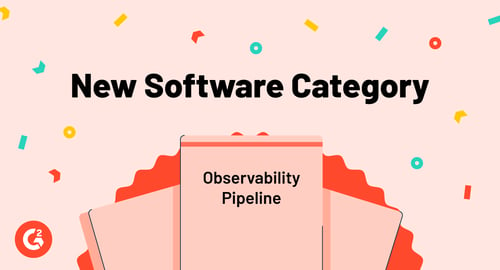In today’s hybrid environment, businesses rely heavily on complex IT infrastructure and applications for daily operations.
IT teams have adopted observability solution suites to monitor on-premises and cloud infrastructures to ensure operational reliability. As a result, telemetry data (logs, traces, and metrics) transferred between hybrid infrastructure and monitoring software has increased exponentially.
The challenge of managing, analyzing, and storing this data becomes critical because processing too much data on monitoring software overruns the IT budget.
Recognizing this increasing need, G2 is excited to announce the launch of a new category: Observability Pipeline Software.
Optimizing the flow of telemetry data with observability pipeline software
Launched in February 2024, the Observability Pipeline Software category empowers organizations to manage the vast amount of telemetry data generated by IT systems.
With IT systems being the heart of these solutions, observability pipeline software serves as the blood vessels for monitoring solutions—routing data from origin to destination points. It is a sophisticated approach that optimizes the flow of telemetry data.
By implementing this practice, businesses can make informed decisions on data reduction, transfer, analysis, and storage within their budget constraint.
Addressing the core challenges of data management
The influx of telemetry data presents several challenges.
Due to the increasing use of cloud infrastructure, the high growth rate of telemetry data strains the capacity of monitoring software.
Cloud infrastructures generate much more telemetry data than traditional on-premises infrastructures. Processing the data manually will slow the monitoring software down and overrun the budget. Not only is there vast telemetry data to process, but a significant portion of the log data offers no analytical value.
Without data optimization, all this noisy data will be processed directly by monitoring software, consuming valuable resources. Storing, indexing, and processing vast amounts of raw, unfiltered telemetry data put unnecessary financial strains on many IT teams.
Even useful log data often lacks the necessary context for humans and monitoring software to understand. DevOps teams often have to come back to the source of the data to dig for additional information to find the root cause.
Some monitoring solutions don’t integrate with cloud services. IT teams need to manually connect to cloud servers because legacy tools cannot authenticate cloud data access with an API.
Hundreds of data sources need to be connected to different monitoring tools. Manually integrating everything would waste an IT team’s time. Without additional help, many IT teams can’t run their monitoring and security solutions within budget.
Buying monitoring software is costly, but maintaining it is even pricier
Let’s look at this graph below to see why being on a budget should be a top priority for monitoring solutions.
The graph shows that the top 5 products from Observability Solution Suites on G2’s ROI periods range from 12 to 22 months. These products are well-known in the industry and are ranked based on Satisfaction and Market Presence scores in the Grid® Report for Observability Solution Suites | Winter 2024.
Even with these top products, it will take an average of one to two years for the software buyer to make their money back.
Buying monitoring software is expensive, but maintaining the monitoring software with a vast influx of telemetric data might drain the IT team's entire budget.
Join the revolution in telemetry data management
Observability pipeline solutions address the data management challenges by revolutionizing how organizations manage their observability data.
The software identifies the valuable segment of log data and trims the rest out, significantly reducing data volume. In addition, the data will be enhanced with additional context. This makes searches faster and more accurate.
The trimmed and enriched data can then be automatically directed from any source to the appropriate monitoring or storage destinations.
If the data needs to be stored, the software usually comes with a cost-effective storage option, reducing expensive and manual storage needs. If the data is routed to monitoring or security software solutions, these solutions will be able to process the data more efficiently since it is smaller in volume.
Therefore, implementing observability pipeline software should improve incident resolution time and reduce IT operation costs.
As telemetry data continues to grow with the adoption of cloud infrastructure, the observability pipeline category will be indispensable to the future of infrastructure monitoring.
By embracing this solution, organizations can tackle the issue of data overload, rising costs, and slow incident management.
Read our analysis of the best enterprise IT management software on the market and find the perfect tool to elevate your IT operations.
Edited by Jigmee Bhutia


 by Tian Lin
by Tian Lin
 by Tian Lin
by Tian Lin
 by Tian Lin
by Tian Lin